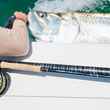Fly reels are expensive. At least, a lot of them are. For the most part, this is with good reason. Fly reels are relatively intricate pieces of equipment that need to be designed in a way that makes them perform reliably. Though playing most trout won't put most reels to the test, fighting bigger species — especially those found in saltwater — requires a well-constructed, strong reel with a powerful drag that you can count on. Anything less simply won't be up to the task.
While more than a few trout anglers have dropped big handfuls of cash on fancy reels, most do so out of desire rather than requirement. Saltwater and other big game anglers, however, need fly reels that they can count on, and so coping with the lofty prices that come with high-performance reels has become an accepted consequence of pursuing bigger prey. These big price tags have long represented a barrier to entry for anglers interested in expanding their horizons from chasing trout to bigger game. Over the last handful of years, manufacturers have tuned into this fact (read: opportunity), and more reasonably priced offerings have been appearing on the market.
Redington's latest offering, the BEHEMOTH and its $109-129 price tag, may be the most extreme example of this trend. The BEHEMOTH, if its name wasn't enough to get the message across, is decidedly aimed at anglers looking to tangle with big fish. The highlight of the BEHEMOTH is its drag package, which at the Redington-rated 30 lbs of weight/capacity, is far burlier than anything we're aware of in its class. In fact, a drag of that power is typically found in high-end reels that price out at around $700-900 (like the Hardy Fortuna), leaving many anglers wondering what gives with the BEHEMOTH and its inarguably reasonable asking price? Surely something must. Right?
Well, as it turns out, not much. The secret to the BEHEMOTH's affordability is its die-cast construction. This is perhaps both the BEHEMOTH's biggest advantage and its biggest cross to bear as, over the years, die cast has become sort of a dirty word in the world of fly fishing – though only partially with good reason (more on this below).
What Works
The Drag System
Given that the BEHEMOTH's drag is the nucleus around which the reel was built, and is its main selling point, it makes sense to start here. While we didn't test the drag strength to verify Redington's 30-pound claim, there's no question that the BEHEMOTH's drag is stout, and provides sufficient drag to chase just about anything you'd seek out with a fly rod — even sailfish. We've tested the BEHEMOTH's drag on bonefish, the blistering runs of bulky false albacore and even fought a bottlenose dolphin, and the drag performed admirably.
A quality drag system isn't all about stopping power, though. Another important factor is how smoothly a reel's drag system engages when a fish is on the line — the drag's startup inertia. A drag that doesn't engage smoothly (as a result of high startup inertia) means rough stops, starts and judders and that translates into lost fish via popped tippets or thrown hooks. Is the BEHEMOTH's drag system as silky smooth as you'd find in some other reels with similar stopping power — like the Nautilus CCF-X2 with its 1% startup inertia (and $500 prie tag) — likely not. But, it is smooth. Decidedly so.
Die Cast Design
The reality is that it is the BEHEMOTH wouldn't exist if it weren't die cast, and so you can't really have a conversation about it without spending some significant time on this fact. If you're not familiar with the details of reel manufacturing, suffice it to say that fly reels are typically borne of one of two materials: die cast or CNC machined aluminum.
CNC reels are machined from a solid piece of bar stock aluminum by tools which are controlled by computers. CNC machined reels are high in strength, bend before breaking, can be anodized to protect against the elements and wear and tear and can be machined with extremely tight tolerances. In addition to higher material costs, CNC reels are costly to machine (per piece) and machining is a time consuming process, making CNC machined reels more suited to smaller production runs — all of which contribute to their high prices.
Die cast reels are made by pouring molten metal into a mould. Over the years, die cast reels have developed a reputation for being cheap, easily broken, hastily manufactured reels with shitty drags. But, in large part, this is due to how most manufacturers making die cast reels have chosen to approach the process. Though die casting (per piece) is less expensive than CNC machining, the process comes with very high initial overhead due to the equipment involved, process of creating moulds and so on — and as a result is much more suited to high volume production. In other words, the people building and selling die cast reels need to sell a lot of them to recover their initial costs. That last bit is why most of the die cast fly reels that have made it to market have focused solely on being cheap — really cheap: commonly around $50 and often significantly cheaper — at the expensive of performing well. Without getting into the nitty gritty about things like gas porosity and shrinkage defects (because we can't, not because we don't want to), the reality is that not all die cast aluminum is created equal — how brittle the casting is, how much torsional strength is has and a number of other qualities are dependent on particulars in the casting process such as the alloy chosen, pressure and temperature — to say the very least.
Redington and product designer Paul Richardson, like a handful of other reel manufacturers before them (e.g. Lamson), approached die cast construction from a different perspective than those that have viewed it only as a way to mass produce poorly engineered reels. Instead, Richardson and Redington leveraged the advantages offered by die casting to produce a reel that could offer durability and performance but without costing upwards of $500. But Redington took it a step farther by slapping a 30-pound drag into it.

Richardson labored over a spool design that has spokes that criss-cross and interlock, meaning that the spool is not made up of several, individual spokes — instead the spokes merge and combine to form one solid-spoke in the injection process. According to Redington, the result is a spool with "incredible" structural strength to prevent torsion and embellish a deep V-cavity for extra capacities on backing. Redington and Richardson also developed a unique frame design for the BEHEMOTH, the result of lab testing that revealed that its powerful drag had the potential to twist and bend the rear frame if it lacked the substantial amount of meat required to prevent it, and so the BEHEMOTH's semi-solid design was born.
Spool Design
Redington likes to point out that because of the intricacy of the BEHEMOTH's spool design, the spool can't be machined (it must be created via mould injection). And, while that's neat, we're not sure it matters all that much. But there are several other aspects of the BEHEMOTH's spool design that most certainly do.
The BEHEMOTH's aforementioned unique, V-cut design provides two distinct advantages. As noted, it holds a lot of line backing. I recently toted the BEHEMOTH 7/8 along on a steelheading outing during which I expected to be throwing bulky skagit heads and sink tips. Despite insistence from the folks at Redington that the 7/8 would do the trick, I balked. I was wrong. The 7/8 BEHEMOTH packed on 150 yards of backing, a running line, and every fat skagit and sink-tip combo I threw at it. For reference's sake — I have 10 weight reels that don't fit this combination as well. Given that all BEHEMOTH models feature the same monster drag, this means a lot in terms of the versatility and breadth of use you'll get out of whichever model you choose.
And, whether Redington intended it to or not, the BEHEMOTH's spool also lays out and picks up line very evenly. Whether during feverish fights with false albacore, picking up and sending out line under tension, or lazily stripping off and picking up loose line during repeated, seemingly endless casting of those aforementioned skagit heads in search of uncooperative steelhead, never once did the BEHEMOTH stack up line unevenly on one side of the spool. For the trout angler, reels that have this tendency are little more than an mild inconvenience, but for the big game angler line that comes off or on the spool unevenly often translates into lost fish.
Price
What is there to say here? $109-$129 is a surprisingly low price for a reel that offers this level of performance. It offers anglers looking to expand their horizons a way to do so without dumping a month's rent down on a premium saltwater reel. And this is a win for everyone, even the guys making premium saltwater reels.
Lifetime Warranty
Love 'em or hate 'em, the BEHEMOTH comes with a lifetime warranty to soothe you and remind you that everything's going to be all right, even if something goes wrong.
What Doesn't
Unsealed Drag
Something had to give, right? Even if only a little bit? Sealed drags have become ubiquitous in this day and age of fly reels. Sealed drags represent a convenience to the customer in that the elements (water, dust, dirt, sand, salt) can't get into the drag and therefore no maintenance is required. This is of particular importance in saltwater environments, as salt can wreak havoc on metal. The BEHEMOTH's drag is capped, not sealed.
But sealed drags aren't a requirement. Careful rinsing after use in saltwater or dusty/dirty environments is typically all that is required on a regular basis. Plus, it is worth noting that high-end reel manufacturers (such as Abel) have been making and selling high-performance reels that sell for well over $700 or $800 dollars that also do not feature sealed drags.
Polymer Coated Reel Handle
I'm a fan of the polymer grips on Redington's Vapen and Chromer fly rods and the BEHEMOTH features a similar material on its reel handle. Yes, the grip is unquestionably nice when cranking on a big fish, especially in hot, sweaty, tropical locations or with gloved hands in the icy cold. But, all the same, I think I'd prefer to go without it because of the fact that it seems to want to grab my fly line. I think it fairly likely that every individual angler's mileage will vary here, as for my part it happened mostly when pitching out under-powered spey casts. Regardless of whether your casting is a sloppy as mine and thus you may experience the same issue or not, this feature may be a solution seeking a problem.
Final Word
Most of what there is to say about the BEHEMOTH has been said above. It is a reel that we've beat up in some pretty demanding conditions and walked away with nothing to complain about. Its price is one that virtually no one can argue with, given the drag, performance and features it offers. Yes, some will have a hard time casting off their concerns about the BEHEMOTH's die cast construction but, with a just-over-$100 price tag and a lifetime warranty — what do you have to lose?































Comments
Paul Schrec replied on Permalink
Hello
The one thing you omitted when discussing the Behomoth is its weight. Though a great bargain, they are very heavy. The 9/10 comes in at 10.8 ounces. More expensive reels such at Lamson Speedster comes in at 5.8... 5 ounces can feel like 5 pounds at the end of a long day on the flats. To provide a truly thorough and fair review, I feel that should have been mentioned.
Thanks you.
Thomas P Steele replied on Permalink
Just got back from Exuma, Bahamas, bonefishing, my 7/8 Behemoth was flawless, liked it better than my other two reels I brought ( Lamson/ Ross) and about the weight 7/8 behemoth 7.5oz Tribor 7/9 8.50z Hatch 7 finatic 8.6oz Sage 6080 7.38oz go figure, not to bad! THANKS
TOM BELL replied on Permalink
This reel is prone to corrosion. After two years of use in saltwater (~100 outings), the finish is blistering off the oxidizing aluminum frame. The one-way bearing is rusting so there is resistance when reeling line in. The reel is rinsed after each use.
The drag is very smooth and it holds lots of backing. It is a bit heavy for its size but it balances well on my 14 ft spey rod. I am buying another one because the price is so good that I can justify throwing the reel away after two years of use.
Kerry replied on Permalink
100 outings in two years? Wow, good for you. I could see investing more $ in a machined reel for that kind of use.
Pages